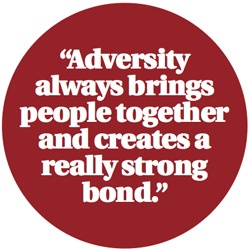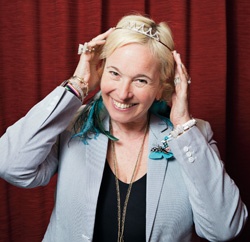Meet The Fixer
As one of industry’s top troubleshooters, Beatrice Lafon has travelled the world saving brands and businesses. Now she is setting down roots as president of Claire’s Accessories Europe, where she is working on an essential recovery plan.
“Whenever I go into a company, the first thing I do is listen,” says Beatrice Lafon, president of Claire’s Accessories Europe. “Do nothing, meet the team, meet the customers and understand what the business is good at and not so good at. From there you must renew the energy, renew the spirit and recreate the will to win - the belief that anything is possible.”
This formula has guided Lafon for over 30 years. During a career spanning 15 companies (see CV, below) and senior roles in ecommerce and marketing, the Paris-born businesswoman has built up a reputation as one of the world’s top fixers - an interim specialist hired to turn around the fortunes of struggling brands and businesses.
Recent credits include returning to profit Dutch fashion retailer Etam in the space of two years as chief executive from 2008 to 2010. She followed that by finding a buyer for liquidation-threatened homeware retailer TJ Hughes during just 12 weeks as the interim boss.
Lafon is now working her magic as president of Claire’s Europe, the accessories and jewellery retailer aimed at six- to 16-year olds, which has more than 1,100 stores. When she joined in October 2011, the European business was grappling with a slide in its trading performance, with sales down 4.4 per cent in the year.
Since Lafon arrived, the turnaround has been swift. Figures for 2012 show an immediate return to sales growth of 1.7 per cent - a boost that helped global profits rise to more than $300m (£190m).
While her reputation as a fixer precedes her, Lafon points out that her appointment at Claire’s was not originally about achieving a turnaround. The role is her first permanent post for several years following a string of interim positions - a sign that she aims to help grow a business over the long term rather than just fix it.

Shortly after joining Claire’s, however, it became clear that her crisis management skills would have to come to the fore once more. “Very often in business, there is a year when a number of issues that have built up over time congregate and have a major impact,” she says.
“That is what happened with Claire’s Europe in 2011. When I was hired, the brief was to accelerate growth - it was not really about recovery. [But] it became about recovery.”
Lafon partially attributes the retailer’s problems to the difficult economic climate in Europe and the fact that it had grown quickly in regions where consumer confidence dipped sharply such as in Spain and eastern Europe. But she also suggests that by the time she joined Claire’s, the business had lost sight of its place in the market and had allowed its brand values to drift.
“We lost our connection with our consumers in terms of truly understanding who she was and what she liked,” explains Lafon. “I think we had become complacent with our success - the business is about 60 years old and has had rapid growth across the world, not just in Europe.
“We just felt we had a recipe that worked and continued with it a little bit blindly. When the market is difficult, then, of course, those kinds of weaknesses are exacerbated.”
On joining Claire’s, Lafon moved to draw up a seven-step recovery plan. In addition to refocusing the business on core European markets like the UK and France, the strategy involved an extensive redevelopment of the company’s product lines. Lafon says this rapid change of direction was supported by Claire’s existing infrastructure, where 90 per cent of products are designed in-house, and by quickly gauging feedback from customers.
“The stock was old, not as fashionable as it could have been and very American in taste,” she notes. “There’s nothing wrong with that when you try to sell it in America but it’s not what the European consumer wants. Customers are very vocal and you can pick up a great deal if you’re prepared to listen.”
Under Lafon’s leadership, Claire’s Europe has introduced 150 new lines per week in order to offer more contemporary designs and greater variety for different markets. The retailer has also cemented its status as a low-cost brand by reducing prices by an average of 5 per cent.
Lafon says that while the majority of Claire’s customers are pre-adolescent girls, teens and women in their early-20s, it is difficult to define the market in terms of age. “It’s more of an attitude,” she adds. “It’s a girl who likes fun, who likes fashion and who wants to be with the times. We connect with the girl when she’s a girl but we also connect with the girl within the woman.”
To better communicate with this target audience, Lafon has overseen the development of a new PR strategy focused on social interactions and music. This includes a tie-up with boyband One Direction. The deal gives Claire’s the right to use the band’s image on its products as well as run competitions and events linked to their concerts.
Lafon believes Claire’s Europe is now in a good position to continue growing. The business, which was bought by private equity giant Apollo Global Management in 2007, has earmarked $89m (£57m) for capital expenditure in 2013, with around 100 stores due to open in Europe during the period.

Last month, the European business also launched its first transactional website. The platform, a major upgrade on Claire’s previous catalogue site, incorporates social media and Spotify integration, how-to fashion videos and a gift finder function that allows parents to buy gifts for their young daughters. Claire’s is also working on a mobile app to support the site.
Although Lafon acknowledges that Claire’s is coming late to the ecommerce party, she believes the site’s level of sophistication will help it attract consumers quickly. “That is going to continue and we expect within the year to actually be leading the market,” she says.
Having presented her recovery plan to the Claire’s board in January 2012, the business began to see positive results within months, Lafon claims. Although she has played a pivotal role in Claire’s turnaround strategy, she suggests that an important part of her job has been to get the best out of an already strong leadership team.
“By early April, results started to come round,” she says. “That’s how quickly you can get results. I was fortunate to inherit a strong team. It wasn’t the case that the team didn’t know what they were supposed to do - it was more that they didn’t necessarily have the structure or empowerment in place to allow them to make the right choices.”
This can-do enthusiasm is a hallmark of Lafon’s career. Although she did not consciously set out to become an expert in the art of fixing, she remembers that even during her first job at Marks & Spencer as a merchandiser, her bosses identified her knack for resolving troublesome issues.
“Although I was at M&S for seven years, every 18 months or so I was parachuted into another area where there was a problem,” she recalls. “They would say ‘so Beatrice what’s the problem, what are the options and how do we resolve it?’ I came to be known as Mr Fix-it.”
After M&S, Lafon had stints at Dorothy Perkins, River Island and Ouiset before joining Woolworths when it was part of Kingfisher, the London-listed owner of numerous European retailers. She worked there for seven years during the 1990s as strategic marketing controller.
It was after this post that Lafon made the decision to become a professional fixer. “At that point, I became a one-man band going wherever was required,” she explains. “I realised that I enjoyed the variety and if I could bring something to the party, I was going to do that.”
Like many troubleshooters, Lafon is full of fascinating insights into the challenges and changes that have occurred at some of the country’s biggest brands. Between 2003 and 2005, for example, she worked at BSkyB to revive its retail division by developing the company’s presence in consumer electronics.

The retail department, which was responsible for Sky Magazine, was a drain on the company’s resources when she first arrived. “The whole essence for Sky was that retail was there as a marketing budget, a way to engage with customers and so it was OK for it to be loss-making,” she says.
“I haven’t been brought up with loss-making being OK so very quickly I put forward ideas to the board of Sky about what else we could do with a retail strategy for it to become an income stream.”
In her role as interim commercial director, Lafon developed a line of Sky-branded televisions. Coinciding with the emergence of Sky’s Believe in Better proposition, the idea was to offer consumers a complete Sky package that would provide the best possible viewing experience.
“High definition was also on the horizon at that time but the kit that consumers had was not there,” explains Lafon. “So for me it was obvious - we were going to create the right product for picture and sound quality that was Sky-branded so that if you had a Sky subscription you could have the very best experience in your home.”
Lafon took decisive action and by the end of 2003, her team had launched a high specification plasma screen for sale in the UK. As the business grew, Sky developed home cinema and audio systems and agreed deals for manufacturers like LG, Hitachi and Panasonic to develop Sky-branded products.
Yet two years later, the entire project was canned after BSkyB decided to exit its retail business following a strategic review by new chief executive James Murdoch. Lafon was retained to oversee the closure of the division.
While she acknowledges the logic in BSkyB’s decision to focus all its attention on its media operations, she appears rueful about the nature of her interim post, which involved creating something before helping to destroy it when the business no longer needed it. “I do it all,” she says. “I build from scratch, I fix, I grow and I close.”
The effect of new owners and management structures is a common theme throughout Lafon’s career. She has a particularly clear view on why Woolworths failed, for example, having worked there during the good times from 1993 to 2000 before returning as interim commercial director in 2005.
During her first spell at the company, Lafon aimed to help the retailer diversify its offer in order to “create a new future for Woolworths”. This included developing a homeware division, a convenience section offering newspapers and fresh flowers and ultimately a general store concept that was trialled in around 50 stores. “It was all the Kingfisher formats under one roof plus food, drink and tobacco,” notes Lafon.
She suggests that Woolworths’s demerger from Kingfisher in 2001 stunted these diversification efforts, resulting in a steep decline in trading performance from which it never recovered. “Suddenly when you haven’t got the backing of Kingfisher in terms of finance you can only do one thing even though you need to do five,” she says.
“You have to make choices and the leadership made the choice to focus on the main core of the business. That was the call they had to make but it meant that all the new shoots that were really the future of the business got killed off.”

When Lafon rejoined the company, it was to fill a gap left by a delay in Woolworths hiring a permanent commercial director. Lafon quickly made her mark by leading a project to introduce the retailer’s first catalogue the Big Red Book.
“I proposed the idea by the end of March and within two days it was agreed in the business and we went to print at the end of June,” she says. “It was a great success - we brought thousands of new products into the business and took £25m incremental turnover from just that one initiative that year.”
Lafon’s extensive grasp of the figures is indicative of a typical troubleshooter’s outlook on their career; one where hard evidence of previous success is necessary to land the next big job at a struggling brand. While Lafon has undoubtedly enjoyed the jet-setting lifestyle of a high-profile fixer, she also acknowledges the downside of having to leave colleagues and friends behind on a regular basis.
“Adversity always brings people together and creates a really strong bond,” she says. “So it’s true that the most difficult part of the job I’ve chosen for myself is to move away from the people.”
Lafon has put an end to this lifestyle by setting down roots at Claire’s - a move also prompted by having a five-year old son and the practicalities of parenthood. “I realised that the globe-trotting life I have because of this job - changing locations, changing home every 18 months or so - was fine before, but with a child there comes a point when you realise it just doesn’t work because of schools, support networks and so on.”
Lafon now lives in the UK, although her role as European president at Claire’s still entails a huge amount of travelling during the week. As a result, she hires two permanent members of staff to look after her son and taxi her to and from the airport at all hours of the day.
While Lafon appears to be a relentless workaholic, constantly seeking out problems in order to fix them, it’s also clear that her career has been driven by an innate belief that any brand can be saved, no matter what troubles it faces (see How I Would Fix…[1]).
“One of my favourite quotes, which has become my motto, is that ‘everything is possible in life, it’s just that the impossible takes a bit longer’.”
CV
October 2011-present
Claire’s Stores, European president
June 2002-September 2011
The Business Intelligence Network, chief executive
January 2011-April 2011
TJ Hughes, chief executive
July 2008-July 2010
Etam Group, chief executive
October 2006-December 2006
Animal, chief executive (interim)
August 2006-October 2006
Tchibo, strategic consultant
December 2005-July 2006
Woolworths, commercial director (interim)
June 2003-July 2005
BSkyB, commercial director (interim)
April 2001-May 2002
Eyestorm Media, managing director
January 2000-April 2001
Homebase, ecommerce director
February 1993-January 2000
Woolworths, strategic marketing controller
February 1992-November 1992
Ouiset, managing director
June 1991-November 1991
River Island, buying director
1989-1991
Dorothy Perkins, buying & merchandising controller
1982-1989
Marks & Spencer, senior merchandiser
References
- ^ see How I Would Fix… (www.marketingweek.co.uk)









